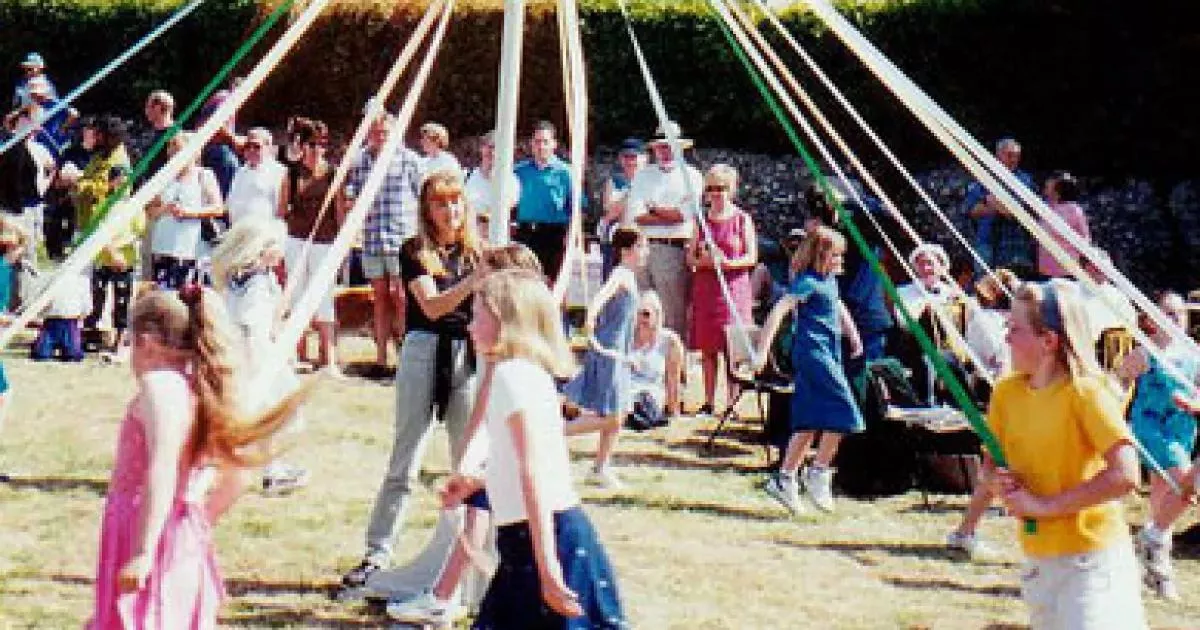May Day is a European festival with ancient roots, celebrated on May 1st to mark the beginning of summer. Celebrations, sometimes starting on May Eve, involve traditions like gathering flowers and branches, weaving floral garlands, crowning a May Queen, and dancing around a Maypole. Bonfires are also a significant part of the festival in certain areas. Regional variations include Walpurgis Night, Beltane, and Calan Mai. It's also linked to the Roman festival Floralia and May devotions to the Virgin Mary. Overall, May Day is a celebration of spring, fertility, and the welcoming of the summer season.
1911: Sir James George Frazer writes about mock battles
In 1911, Sir James George Frazer wrote in The Golden Bough about mock battles between Summer and Winter on May Day.
1912: Alexander Carmichael Collects The Beltane Blessing
In 1912, folklorist Alexander Carmichael collected the song Am Beannachadh Bealltain (The Beltane Blessing) in his Carmina Gadelica, which he heard from a crofter in South Uist.
1923: 'Dancing the sun up' tradition begins in Oxford
In 1923, the tradition of 'dancing the sun up' began in Oxford, which includes dances, traditional May Day songs, and sometimes other activities such as mummers' plays or bonfires, to welcome the sun and summer season. It has spread across the world since then.
May 1927: First Lei Day Celebrated in Honolulu
In May 1927, the first Lei Day was celebrated in Honolulu, invented by poet and local newspaper columnist Don Blanding. The day is set aside to celebrate island culture in general and the culture of the Native Hawaiians in particular.
1933: Nazi Germany Declares National Workers' Day
In 1933, May Day was established as a public holiday when Nazi Germany declared 1 May a "national workers' day". Political parties and unions began hosting activities related to work and employment.
1955: Pope Pius XII establishes feast day of St. Joseph the Worker
In 1955, Pope Pius XII established 1 May as one of two feast days for St. Joseph the Worker, the Catholic patron saint of workers, as a counterpoint to the communist International Workers' Day celebrations.
1976: Revival of Jack in the Green festival in Whitstable
In 1976, the Jack in the Green festival was revived in Whitstable, Kent, and continues to lead an annual procession of morris dancers through the town on the May bank holiday.
1978: Creation of the Early May Bank Holiday
In 1978, the early May bank holiday on the first Monday in May was created. May Day itself – 1 May – is not a public holiday in England unless it falls on a Monday.
1983: Revival of Jack in the Green festival in Hastings
In 1983, a separate revival of the Jack in the Green festival occurred in Hastings and has become a major event in the town calendar.
1993: John Major Government attempts to abolish May Day holiday
In 1993, the John Major government made attempts to abolish the May Day holiday and replace it with Trafalgar Day.
2001: Emergence of Durham May Day Tradition
Since 2001, students of the University of Durham gather on Prebend's Bridge to see the sunrise and enjoy festivities, folk music, dancing, madrigal singing and a barbecue breakfast as an emerging Durham tradition.
February 2011: UK Parliament Considers Scrapping May Day Bank Holiday
In February 2011, it was reported that the UK Parliament was considering scrapping the May Day bank holiday, replacing it with a bank holiday in October to create a "United Kingdom Day".
May 2014: Kingsbury Episcopi May Day Festival attracts thousands
In May 2014, the yearly May Day Festival celebrations in Kingsbury Episcopi, Somerset, attracted thousands of revellers to enjoy traditional maypole and morris dancing, as well as contemporary music acts.
2024: Morris dancers celebrate May Day in the US
In 2024, Morris dancers continued the English custom of 'dancing the sun up' on May Day in Colorado, Connecticut, Illinois, Maryland, Massachusetts, Minnesota, Missouri, Montana, Oregon, Pennsylvania, Rhode Island, Washington, and Wisconsin.
Mentioned in this timeline
Germany officially the Federal Republic of Germany is a Western...
Pennsylvania is a U S state located in the Mid-Atlantic...
Connecticut is a state in the New England region of...

Music is a cultural universal involving the arrangement of sound...
Illinois is a Midwestern U S state bordering Lake Michigan...
Colorado a Mountain and Southwestern U S state is the...
Trending
7 days ago Lucas Paqueta Faces Turmoil: FA Probe and Liverpool Red Card Impact West Ham

Brett Rypien is an American professional football quarterback for the Minnesota Vikings He played college football at Boise State before...

2 months ago Luis Suárez shines as Sporting faces Napoli amid fan clashes in Champions League.

9 months ago Aniston and Pascal spark dating rumors after dinner, while Theroux reportedly weds.
6 months ago Dodgers Defeat Padres: Smith's Walk-Off Homer Secures Victory in Historic Game

Jeff Passan is a prominent American baseball sportswriter and author He is known for his in-depth reporting analysis and commentary...
Popular
Matt and Ross Duffer known as the Duffer Brothers are...

Candace Owens is an American conservative political commentator and author...

Ilhan Omar is an American politician currently serving as the...

XXXTentacion born Jahseh Dwayne Ricardo Onfroy was a controversial yet...

Tom Cotton is an American politician and Army veteran currently...
Aftyn Alyssa Behn is an American politician currently serving as...
